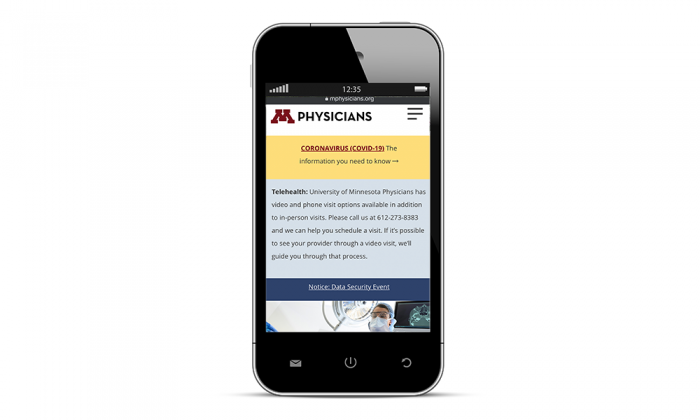
With the onset of COVID-19, healthcare organizations moved quickly to keep care accessible while minimizing the risk of infection. Broadway Family Medicine Clinic, as well as M Health Fairview Clinics—Smiley’s, Bethesda and Phalen clinics—have all implemented telehealth strategies to continue providing care for those who otherwise might not receive it.
So far, telehealth has demonstrated that in-person visits aren’t necessary for high-quality primary care, and in many instances, it can even add convenience for the patient. Telehealth eliminates or minimizes the need for public transportation, time off from work or childcare, and allows patients to get help while they’re busy completing other tasks.
Pita Adam, MD, MSPH, vice chair for clinical affairs in the Department of Family Medicine and Community Health at the University of Minnesota Medical School, has seen firsthand the benefits of telehealth.
We think that this is part of the new normal moving forward. We’re going to find the right balance of video and phone, but we are absolutely going to continue to provide these services.
Dr. Adam
But, there are still structural barriers for many people, such as not having enough cellular data for video or not having reliable access to video equipment, a smartphone or high-speed internet. So, the team at Broadway Clinic initiated a research program to better understand the barriers affecting their patients.
“Patients really like it, and I think they’re going to want to continue this option, so we need to figure out how it’s sustainable from a reimbursement perspective and also to ensure that it’s available to everyone, not just the patients with the most resources. We need an equitable distribution,” said Andrea Westby, MD, a family medicine physician at the Broadway Clinic.
Previous literature focuses more on the barriers for the provider and organization rather than for the patients. For example, physicians recognize that phone consultations without video do have limitations when looking at a patient to check for symptoms, but now, Drs. Westby, Adam and colleagues are hoping to learn from the patient’s perspective about how access to telehealth can be improved.
Oftentimes, it is the most vulnerable patients who struggle to receive care. Those who don’t have access to a private space to discuss medical conditions on the phone, who are limited in english proficiency and who are older individuals and struggle with technology are all at a disadvantage.
We want to know if there are barriers we haven’t identified or didn’t expect to see. It's important that how and when we implement telehealth that it’s done equitably, so that the people who need it most can access it easily.
Dr. Westby
Feedback from patients has been crucial to understanding how telehealth can adapt to each individual’s situation and needs. Through qualitative research, the team hopes to identify and address barriers and continue providing quality care that’s easily accessible.
Solutions will depend on what the team finds as primary barriers. If equipment is the problem, they may explore grants to provide web cameras for people, or partnerships to get unlimited data plans with corporate parties. If it is a technology issue, they may consider providing educational sessions to teach people how to conduct a video visit. The research will provide next steps on what the community and patients think are sustainable solutions.
Telehealth
University of Minnesota Physicians has video and phone visit options available in addition to in-person visits. Please call us at 612-273-8383 and we can help you schedule a visit. If it’s possible to see your provider through a video visit, we’ll guide you through that process. To find your specific clinic’s information, visit our clinics page.